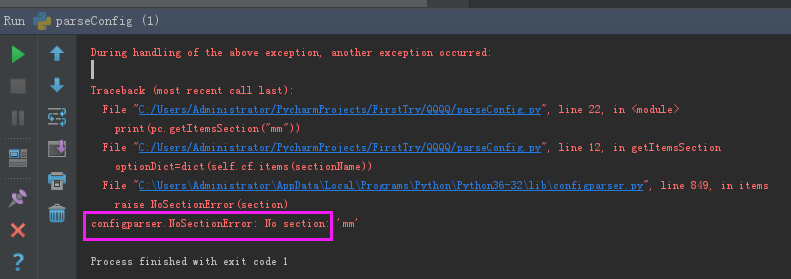在使用configparser时候应注意:
①配置文件(ini文件)的存放位置:配置文件和调用文件放在同一个文件包下面。
使用read()函数读取并解析配置文件时,直接写配置文件(ini文件)的文件名即可。
例如:
cf=ConfigParser() #实例化
cf.read("PageElementLocator.ini") #读取并解析配置文
②配置文件(ini文件)的存放位置:配置文件和调用文件未放在同一个文件包下面。
使用read()函数读取并解析配置文件时,则需要写配置文件(ini文件)存放绝对路径。
例如:
parentDirPath=os.path.dirname(os.path.dirname(os.path.abspath(__file__))) #os.path.dirname(os.path.dirname(os.path.abspath(__file__))) 获取当前文件所在目录的绝对路径 注意:该路径不包含当前目录
path=parentDirPath+'\config\PageElementLocator.ini' #获取配置文件的的绝对路径
cf=ConfigParser() #实例化
cf.read(path) #读取并解析配置文件
未遵循上述两点,或者配置文件的路径写错,均会出现错误configparser.NoSectionError: No section

③items()此种方法获取到的配置文件中的options内容均被转换成小写。
例如:test.ini 内容:
[peizhi] A=Hello B=Word
test.py 内容:
from configparser import ConfigParser
cf=ConfigParser()
cf.read("test.ini")
print(cf.items("peizhi"))
执行结果:items获取配置文件中指定的section下的所有键值对。

如果需要把items的返回结果以字典类型返回,那么需使用dict()方法。修改 test.py 内容:
from configparser import ConfigParser
cf=ConfigParser()
cf.read("test.ini")
print(dict(cf.items("peizhi")))
再次执行,结果如下:
